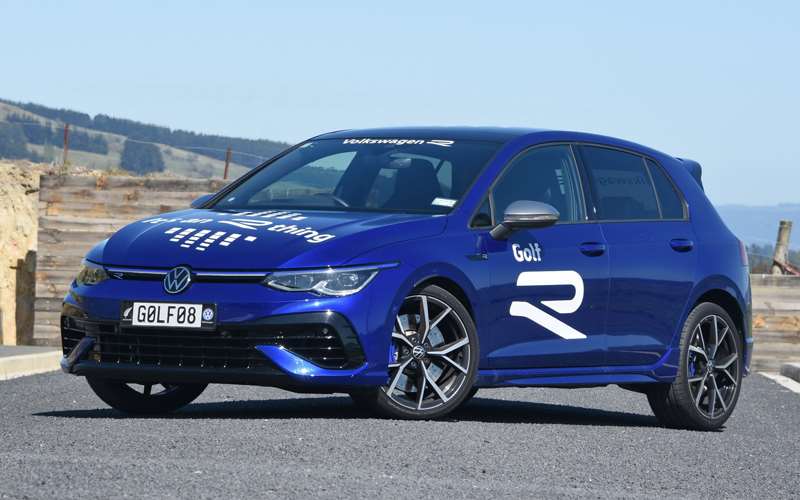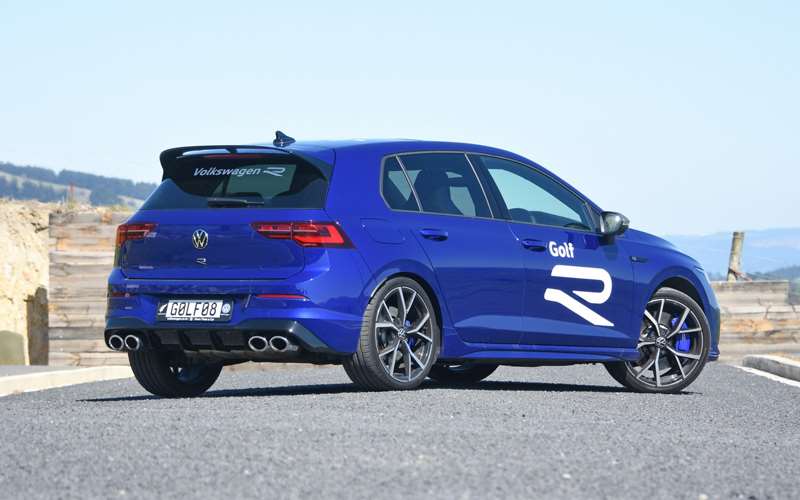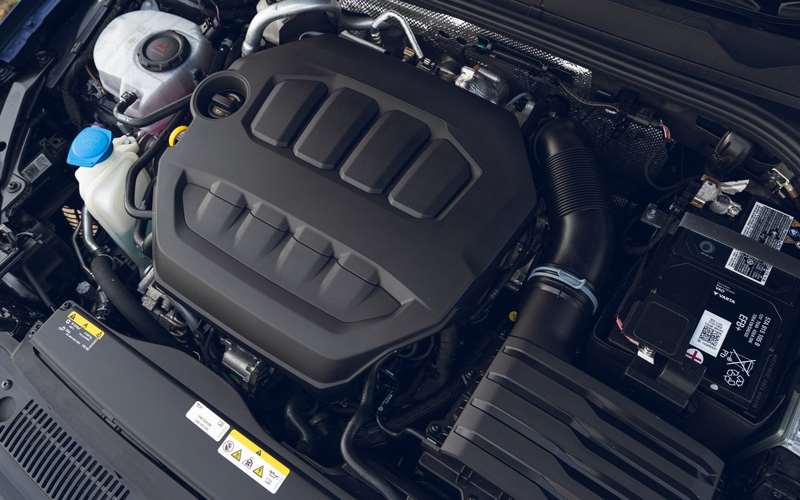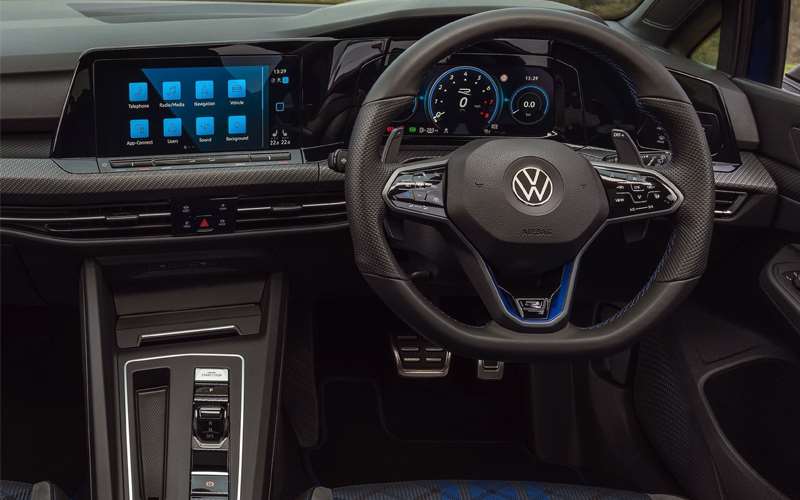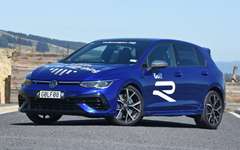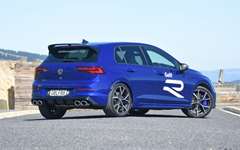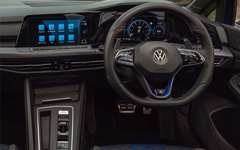The latest VW Golf R is following in the footsteps of a hot hatch legend. David Thomson discovers what it has to offer.
What’s new?
Its predecessor was the best Golf R ever and, arguably, the best hot hatch of its generation. What, then, was the mark Volkswagen intended the latest generation to make?
Certainly not that of transition to a brave new electric future. VW’s ambitions in that regard are firmly placed within its new ID sub-brand, slated for a full-on Kiwi debut early next year.
More likely is a definitive sign-off for the conventional pure-petrol hot hatch recipe.
To that end, there was a certain inevitability about the Mk8 Golf R taking a cautious evolutionary path.
The same 2-litre turbo engine of the Mk7 variant carries over into the new machine, with tweaks to lift peak outputs a shade to 235kW and 400Nm. And, as before, the engine mates to a 7-speed DSG transmission, with power delivered to all four wheels.
Though there’s a fresh underlying platform, the wheelbase is virtually unchanged, and gains in length and width are fractional. A weight increase of 16kg largely offsets the power lift, and the Mk8 Golf R’s practically irrelevant but symbolically all-important 0-100kmh time of 4.8sec is a tenth of a second shy of the Mk7’s 4.7sec benchmark.
How is it, then, that when pressed around Germany’s daunting Nurburgring Nordschliefe race circuit, the latest Golf R’s lap time of 7min 47sec bests its predecessor by four seconds?
Chalk that improvement up to the cumulative impact of revised suspension damping, reductions in unsprung mass, bigger front brakes and — probably most important of all — a new R Vectoring Torque control system. Operating as part of the vehicle’s 4Motion all-wheel-drive system, this vectoring system varies the torque apportionment between the rear wheels and can even deliver all that torque to just one wheel, to optimise dynamic efficiency and balance.
Power delivery from the engine to driveline is entrusted to a seven-speed dual-clutch gearbox, the manual option having been phased out in the life of the previous Mk7 R. All Golf Rs in the Mk8 line are five-door machines.
The standard R carries a $79,990 tag. Adding in two extra driving modes (‘Drift’ and ‘Special — Nurburgring’), a special rear spoiler, panorama sunroof and premium Harman/ Kardon sound system, the First Edition variant sampled in this test stickers at $85,990.
What’s it look like?
The exterior dimensions of the standard Golf Mk8 are virtually unchanged from the Mk7, though precise measurement will show that the R model is longer and lower than its equivalent in the previous range.
Ride height is reduced by 20mm for the R, with low-profile 235/35 Hankook tyres fitted to 19-inch alloys. The prominent creases and feature lines central to the crisply tailored Golf Mk8 look suit the R especially well, and are augmented by a special styling kit that includes custom sports bumpers, side skirts, blue brake calipers, quad exhausts and — on the First Edition — a body-coloured rear spoiler.
If there are complaints to be made about the styling, they will surely be that the Golf R doesn’t visually showboat its high-performance credentials to the same extent as some of its rivals. Personally, I like the relatively low-key approach.
What comes as standard?
Keyless entry and push button start, tri-zone climate control, a heated steering wheel, heated and chilled power-adjusting front seats, and combination Nappa leather trim are all standard on the Golf R. Dual USB-C ports are provisioned front and rear, and the multimedia interface includes satellite navigation, smartphone mirroring, and a comprehensive voice control interface. A digital main instrument cluster is augmented by a head-up display and both are customisable in various ways.
Premium IQ matrix headlights are fitted as part of an all-LED exterior lighting package that also includes front and rear fog lamps, and strip lighting across the grille. The interior lighting system includes LED ambient lighting with 30 different colour options.
The standard Golf R safety package embraces a range of active safety technologies, including autonomous emergency braking, pedestrian and cyclist monitoring, adaptive radar cruise control, lane-keeping assistance, and parallel parking assist.
What’s it like inside?
A minimalist approach to design is apparent within the cabin.
The R-embossed front seats are attractively trimmed in combination nappa leather trim with blue piping and highlighting, while the clean-lined dash features a pleasing mix of premium contrast surfaces. A 10-inch centre touchscreen and a strip of touch controls immediately below it, play lead roles in button declutter. A fully digital instrument cluster is also provided.
Set just behind the combination lidded storage tray and wireless charge pad, a stubby drive selector on the centre console is there simply to engage drive. Any driver-controlled gear-shifting is via the paddle controls on the steering wheel. The main drive mode selector is located below the touchscreen and there is also a blue ‘‘R’’ button on the steering wheel to select drive modes quickly.
It’s disappointing that the Golf R reverts to hard-touch upper door trims in the back. The rear of the cabin is every bit as roomy as that of the regular Golf and possessed of handy features such as smartphone-sized carry pockets on the upper seat backs.
A 60:40 split rear seat with fold down armrest and load-through ski flap provides great load carrying flexibility.
Boot space in the regular R is 374 litres, but there’s no spare wheel and, on the First Edition, the extra storage space under the main boot floor is partly occupied by elements of the sound system.
What’s it like to drive?
The Golf R offers an excellent driving position; its sports seats are snug and supportive, key controls are nicely positioned, and the combination of digital instrument screen and head-up display provides ample information.
Efforts to minimise button clutter are reasonably successful. However, the strip of capacitor touch controls immediately below the centre touchscreen are easy to activate accidentally while accessing the screen.
The Golf R’s engine is subdued in comfort drive mode, which is certainly the most civilised and easy-going option for round town motoring and highway cruising.
Sport mode activates the first stage of an artificially enhanced engine burble and sharpens the throttle and steering response, as well as the damping and power delivery settings. Race mode takes things a step further, and the First Edition variant as tested has the option of special Nurburgring and drift modes.
The Nurburgring option mimics the settings used to secure the record lap time referred to above and is a viable option for a decent blast on any stretch of winding tarmac. Making the most of this special mode demands the driver focuses on the business of driving.
Drift mode is definitely not for public road use. I didn’t try it at all but my ODTcolleague Richard Bosselman has experienced it on a closed track in the company of Kiwi racing legend Greg Murphy and reckons it’s a hoot.
Returning to road use, fierce and relentless acceleration is delivered in tandem with superslick gearshifts; so much so, that the only occasions I found myself using the paddle shift controls with serious intent was to place the car into the best gear on entry into corners.
The R Performance Torque Vectoring system and associated traction aids do superbly well in providing fine cornering balance and the sportiest of modes delivers a feel more akin to a rear-drive performance car than a front or all-wheel-drive machine. Back off the pace and commitment a notch, and agile yet utterly secure handling is matched to impressively capable brakes and precise, well weighted steering, making this an easy car to thread through demanding twists and turns at speed.
Even in comfort mode, ride can be choppy at slow speeds, but beyond city limits there is adequate ride compliance for a car of this type over most surfaces. The bugbear is road noise, Coarse chip rumble is intrusive and likely to prove tiresome on longer trips.
Verdict
The minimalist interior may not appeal to everyone, and the capacitive touch buttons are fiddly to use, but those are minor criticisms to level at car that excels in its key mission, which is to provide a compellingly capable and truly memorable hot hatch performance experience. THE week before the Golf R arrived, its SUV counterpart — the Tiguan R — graced my driveway.
It runs the exact same powertrain as the Golf R but sits on the previous iteration of Volkswagen’s MQB platform.
It is also longer (by 50mm in wheelbase, and 224mm overall), taller (by 229mm), wider (by 70mm) and heavier (by 188kg).
A different set of drive modes — eco, comfort and sport — are provided too.
Of these modes, I felt eco robbed the Tiguan R of too much sparkle and mechanical vim.
However, comfort provided superior long-haul cruising ability to that delivered by the equivalent mode on the Golf R, mainly because the Tiguan R rides better, and road noise is well suppressed.
Even in sport mode it is not as rapid in a straight line as the Golf R yet, with a 0-100kph time of a shade under 5 seconds, it is still darn quick.
It is less nimble through the twists and turns too, with its extra weight and a higher centre of gravity causing a little body roll and taking the edge off cornering precision.
That said, the Tiguan R is still a highly capable sports machine by the standards of the mid-sized SUV class.
As with all SUVs, the Tiguan R bests its conventional hot hatch counterpart for practicality — try a 615-litre boot for starters, and add more rear room and better visibility from all its seats into the mix, and the appeal factors starts to notably lift.
The key infotainment and drive displays are the same, but while the touch-sensitive control strip below the centre touchscreen is still a fiddle to use, the Tiguan R’s higher seating position means its much harder to accidentally activate the control strip while accessing the touchscreen.
Pricing is $83,990 for the standard Tiguan R, and $88,990 for the First Edition, with an additional $1,955 clean car fee payable for either variant.
- David Thomson
Photos: David Thomson
